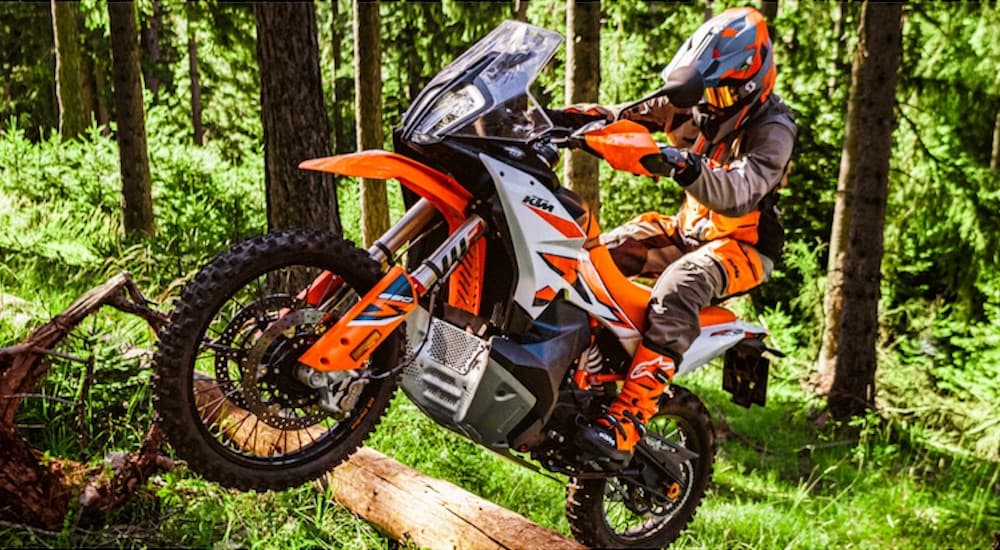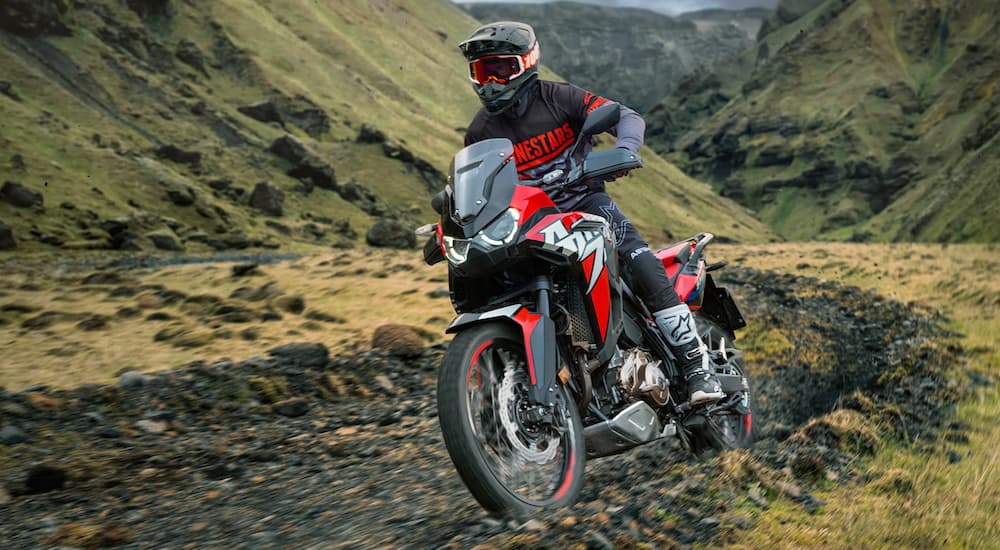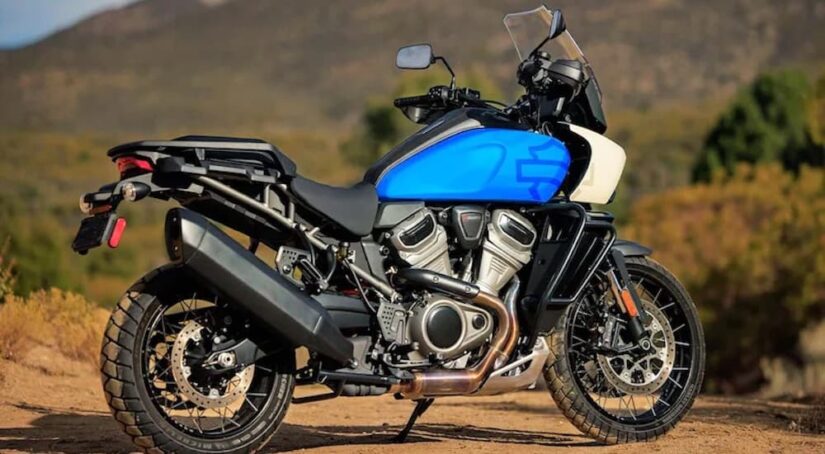If you’re looking for a great multipurpose bike that can easily transition between on and off-road routes, an adventure bike might just be the perfect fit. Often referred to as the SUV of the bike world, adventure bikes are versatile enough to traverse challenging off-road scenarios without losing anything in the way of on-road performance. Once something of a niche, the segment has been on the rise in recent years, with some of the industry’s biggest names, like Ducati and Harley-Davidson, throwing their hats into the ring.
The go-anywhere attitude of adventure bikes is ideal for long overlanding journeys, allowing riders to seamlessly transition between different types of riding with confidence. Sure, adventure bikes might not always be the best choice for every rider and every situation, but if you’re looking for a well-rounded bike that can hold its own no matter where the road might take you, they’re an alluring option. So what do you need to know before buying an ADV bike? Join us as we take a closer look at some of the pros and cons of the adventure bike segment and share a few tips for finding the perfect model to fit all your bike touring needs.
Pros and Cons of an Adventure Bike
Adventure bikes are about as versatile as they come, but they might not be the correct fit for every rider or every riding scenario. Before we get into some of the specifics about what makes a good adventure bike, let’s examine some of the pros and cons of the category and see if an adventure bike is the right choice for you.
Pros
First off, most adventure bikes provide great on-road performance, allowing riders to cruise down the highway without feeling out of place. Middleweight and heavyweight adventure bikes have plenty of horsepower for overtaking other vehicles and maintaining high speeds and tend to be very stable no matter how high the speedometer gets. They’re also very stable in the wind, which should give drivers the confidence to set out on a ride no matter what the forecast has in store.
The upright riding position common to most adventure bikes allows for solid ergonomics, resulting in more road awareness and less fatigue, especially on longer rides. Adventure bikes have all the cargo and passenger capacity a rider could ask for, which comes in handy when you’re on a road trip, as it’s easy to outfit adventure bikes with additional storage without significant sacrifices in performance. Lastly, modern adventure bikes are packed with all the electronic assistance a rider could ask for, with adjustable ABS, suspension, and traction control taking a lot of the guesswork and painful trial-and-error lessons out of the riding experience.
Cons
Despite their versatility, adventure bikes do come with some drawbacks that a rider should be familiar with before diving into the segment. Adventure bikes, especially those in the middleweight and heavyweight categories, can be a little intimidating when you leave paved roads behind due to their weight. These bikes can become mired in loose, sandy surfaces, and control can be an issue when you’re moving at slower, off-road speeds. The power can also be a bit overwhelming for those not accustomed to off-road riding, where the ability to toe the line between speed and control can be so important.
If you do have an accident, repairs can be expensive as the expression “the bigger they are, the harder they fall” is painfully relevant to the adventure bike segment. The weight of the bike can damage expensive parts like luggage racks and fairings should it tip over and can be a dealbreaker for older or smaller riders who might have trouble righting a 500-plus-pound bike. All-in-all, there’s a reason why most riders don’t tend to gravitate toward the adventure segment when it comes time to pick their first bike. Adventure riding offers some fun challenges, but the experience will be a lot more fun if you’ve already learned the basics of on and off-road riding on more purpose-built bikes.

Finding the Right Adventure Bike for You
When first getting into a new sport or hobby, there’s always the temptation to cut your teeth on the biggest, baddest challenges on offer. In rare cases, this might work out just fine, but a majority of the time, it ends in frustration, disappointment, and even injury. “Beginner’s luck” might be a popular trope, but it should not form the cornerstone of your riding philosophy as a new adventure bike owner.
So how does this apply to the world of adventure bikes? In a word: displacement. Larger engines offer unmatched power and torque, giving riders the ability to tear through tight corners, burn up the straightaways and produce those ear-splitting revs that are the hallmark of any good bike. That said, they’re not a great choice for less experienced riders. The statistics don’t lie: according to a study by the National Highway Traffic Safety Administration (NHTSA), motorcycles with engines of 500cc and above account for 40 percent of all accidents, while those in the smaller range tend to be much safer. Too many riders start out with the largest adventure bike they can find, only to get scared off after a sketchy ride or accident. Starting off small allows a rider to learn the basics of adventure riding in a low-stakes environment and develop the good habits that will make the transition to middleweight and heavyweight bikes so much easier.
Lightweight, Middleweight, or Heavyweight?
Generally speaking, adventure bikes are separated into three categories––lightweight, middleweight, and heavyweight––based on their engine size and cylinder count. Each category has its pros and cons, so let’s take a quick look and see how each one compares when it comes to on and off-road performance.
Single-cylinder lightweight bikes feature engines that fall anywhere between 125cc and 600cc and weigh less than 400 pounds. These bikes are great for off-road riding thanks to the low-end power they’re able to produce due to their low weight. Perfect for riding in wooded, obstacle-strewn trails, lightweight bikes can easily crawl over logs, stumps, rocks, and other off-road hazards. The smaller engine also means they’re more efficient, meaning more riding and less stopping to refuel, but they’re not ideal for on-road riding. Lightweight bikes tend to lack the performance of larger, heavier options when it comes to riding on paved roads and are also usually much less comfortable. If your adventure riding is going to take place mostly on off-road trails, a lightweight bike could be an ideal companion, but if you’re looking for a well-rounded motorcycle that can hold its own on the asphalt, consider upgrading to a middleweight or heavyweight model.
Middleweight, twin-cylinder bikes represent the sweet spot for most adventure bike riders, making them one of the most popular choices of the three. Weighing in between 400 and 500 pounds, these 600cc to 900cc bikes are a true jack-of-all-trades. Middleweight bikes have plenty of low-end power for surmounting off-road obstacles but can also hold their own when it comes to sharp, twisty roads and wide-open highways. These bikes are still light enough for most riders to pick up if they should hit the dirt, which can be an important consideration if you’re into riding solo. While not quite as efficient as lightweight bikes, middleweight adventure motorcycles don’t run through consumable parts like tires and brake pads quite as quickly as heavyweight bikes, thanks to their relatively lower power. The major drawback of middleweight bikes comes down to a lack of power and protection from the wind and elements when compared to heavyweight bikes.
Then there are the heavyweight adventure bikes. Defined as any bike with two or more cylinders, a 900cc-plus engine, and a curb weight above 500 pounds, heavyweight bikes are the undisputed leader when it comes to raw power. Ideal for on-road riding, heavyweight bikes can navigate twists and turns with ease and offer great overtaking potential on the highway. Featuring larger fairings and bodywork than the other two categories, heavyweight bikes offer great protection from the wind, which is important if you see a lot of higher-speed highway riding in your future.
Heavyweight bikes often serve as a brand’s flagship model, with all the benefits that the title implies. These bikes are usually among the first to be graced with new gizmos and gadgets, giving riders the chance to test out the latest and greatest in motorcycle technology. The biggest downside of heavyweight adventure bikes is their off-road performance. Lacing the low-end power of lightweight and middleweight bikes, heavyweight adventure bikes can have a tough time overcoming some off-road hazards. Heavyweight bikes also lack the low center of gravity you’ll find on smaller bikes due to their increased weight and the way that it’s distributed across the bike. That makes for a less agile, responsive ride, but the negative effects of a high center of gravity can largely be negated by choosing a bike with a low-slung fuel tank. When full, a low fuel tank will significantly improve a bike’s center of gravity, allowing riders to recoup some of their cornering ability without sacrificing power.
Wheel Size
Whether lightweight, middleweight, or heavyweight, most adventure bikes tend to come in either of two front-wheel sizes: 19 inches and 21 inches. While it might not sound like much of a difference, those two inches of diameter can make a big difference when you’re out on a ride. So how do they compare?
19-inch wheels are usually found on more street-focused adventure bikes as they provide a more agile platform for navigating paved surfaces. If off-road riding is more your thing, a bike with a 21-inch front wheel might be a better choice. The larger front wheel comes in handy when climbing over logs, rocks, rain ruts, and other common off-road impediments, making the 21-inch wheel the perfect choice for chewing through the underbrush.
For those who are curious, the rear wheel on most adventure bikes measures in at either 17 or 18 inches. These back wheels don’t tend to have as much of an impact on performance as the front wheel, so the size usually comes down to a matter of preference and how well it pairs with the front wheel.

Tube vs Tubeless Tires
To tube or not to tube, that is the question. Tube tires are still the go-to choice for enduro and dual-sport motorcycles, but tubeless tires reign supreme when it comes to the adventure bike segment. There’s one big reason for this sort of dominance: when faced with a simple tread puncture, tubeless tires are much easier to fix mid-ride, meaning fewer interruptions and more time on the trail. But not all punctures are created equal. When faced with a sidewall puncture, tubeless tires can actually be much more difficult to fix on the trail than their tube-full counterparts. Rim dents are another big risk for tubeless tires, which means that they often need to be run at a higher pressure than tube tires. As any experienced rider knows, the ability to let a little air out of your tires can make a big difference when riding off-road, which limits the usefulness of tubeless tires to some degree.
Get Your Perfect Adventure Ride
Adventure bikes represent a tantalizing option for drivers who refuse to limit themselves to one type of riding. Proficient in both on and off-road environments, adventure bikes are a great way to explore everything from busy highways and rolling interstates to rutted dirt trails, rocky canyons, and more. That said, it’s important to know what you’re getting into and what designs, equipment, and setups are right for you.
From choosing between tube and tubeless tires to the pros and cons of different wheels, overall weight, and engine sizes, there’s a lot to consider when you set out to find your next adventure bike. Hopefully, this guide has served to demystify the segment and get you familiar with some common considerations when it comes to choosing an adventure bike, but if not, your local motorcycle dealership is always a great resource. Not only can these experts point you in the direction of the right model for your specific needs, but they can also share some hard-earned knowledge about the local riding scene, trails, and other factors that could come in handy as you start exploring the wide open road––or trail––from behind the handlebars of your new adventure bike.



